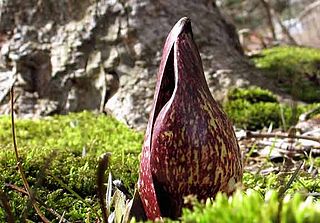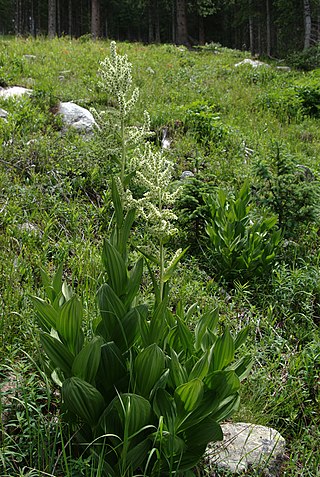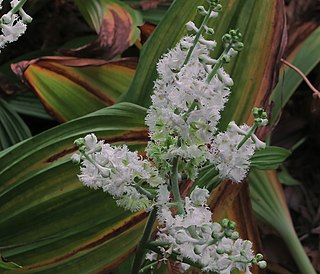
Allium ursinum, known as wild garlic, ramsons, cowleekes, cows's leek, cowleek, buckrams, broad-leaved garlic, wood garlic, bear leek, Eurasian wild garlic or bear's garlic, is a bulbous perennial flowering plant in the amaryllis family Amaryllidaceae. It is native to Europe and Asia, where it grows in moist woodland. It is a wild relative of onion and garlic, all belonging to the same genus, Allium. There are two recognized subspecies: A. ursinum subsp. ursinum and A. ursinum subsp. ucrainicum.

Melanthieae is a tribe of flowering plants within the family Melanthiaceae. Molecular phylogenetic studies in the 21st century have resulted in a large-scale reassignment of many of its species to different genera; in particular the genus Zigadenus (deathcamases) has been restricted to a single species, Zigadenus glaberrimus. Plants contain alkaloids, making them unpalatable to grazing animals; many are very poisonous to both animals and humans.

Skunk cabbage is a common name for several plants and may refer to:
White hellebore or white false hellebore is a common name for several plants and may refer to:

Maianthemum racemosum, the treacleberry, feathery false lily of the valley, false Solomon's seal, Solomon's plume or false spikenard, is a species of flowering plant native to North America. It is a common, widespread plant with numerous common names and synonyms, known from every US state except Hawaii, and from every Canadian province and territory, as well as from Mexico.

Baptisia australis, commonly known as blue wild indigo or blue false indigo, is a flowering plant in the family Fabaceae (legumes). It is a perennial herb native to much of central and eastern North America and is particularly common in the Midwest, but it has also been introduced well beyond its natural range. Naturally it can be found growing wild at the borders of woods, along streams or in open meadows. It often has difficulty seeding itself in its native areas due to parasitic weevils that enter the seed pods, making the number of viable seeds very low. The plant has low toxicity levels for humans.

Veratrum is a genus of flowering plants in the family Melanthiaceae. It occurs in damp habitats across much of temperate and subarctic Europe, Asia, and North America.
Bear corn is a common name for several plants and may refer to:

Veratrum album, the false helleborine, white hellebore, European white hellebore, or white veratrum is a poisonous plant in the family Melanthiaceae. It is native to Europe and parts of western Asia.

Veratrum nigrum, the black false hellebore, is a widespread Eurasian species of perennial flowering plant in the family Melanthiaceae. Despite its common name, V. nigrum is not closely related to the true hellebores, nor does it resemble them.

Veratrum californicum is an extremely poisonous plant native to western North America, including the Sierra Nevada and Rocky Mountains, as far north as Washington and as far south as Durango; depending on latitude, it grows from near sea level to as high as 11,000 feet. It grows 1 to 2 meters tall, with an erect, unbranched, heavily leafy stem resembling a cornstalk. It prefers quite moist soil, and can cover large areas in dense stands near streams or in wet meadows. Many inch-wide flowers cluster along the often-branched top of the stout stem; they have 6 white tepals, a green center, 6 stamens, and a 3-branched pistil. The buds are tight green spheres. The heavily veined, bright green leaves can be more than a foot long.

Streptopus amplexifolius is a species of flowering plant in the family Liliaceae, native to North America, Europe and Asia.
Veratrum insolitum is a species of false hellebore, a type of plant closely related to the lily. Its common name is Siskiyou false hellebore. It is native to the northwestern United States: Washington, western Oregon, and northwestern California as far south as Trinity County.

Veratrum fimbriatum is an uncommon species of false hellebore, a type of plant closely related to the lily. Its common names are fringed false hellebore and fringed corn lily. It is endemic to California where it is a rare resident of the northern coastal scrub plant communities of Mendocino and Sonoma Counties. This flowering plant is a stout, hollow-stemmed perennial growing from a thick rhizome. The erect flowering plant bears several large, flat, green leaves near the base of the green stem. The large panicle inflorescence is packed with many distinctive, lacy-fringed flowers each up to a centimeter wide. The flower bud is club-shaped before it opens into a bloom of six frilly tepals, each of which bears two bright green or gold glands. The ovary and sepals extend straight outward as one thick stalk. The fruit is an oval-shaped capsule just under a centimeter long containing the seeds.

Crinum asiaticum, commonly known as poison bulb, giant crinum lily, grand crinum lily, or spider lily, is a plant species widely planted in many warmer regions as an ornamental. It is a bulb-forming perennial producing an umbel of large, showy flowers that are prized by gardeners. However, all parts of the plant are poisonous if ingested. Some reports indicate exposure to the sap may cause skin irritation.

Sambucus racemosa is a species of elderberry known by the common names red elderberry and red-berried elder.

Sapindus saponaria is a small to medium-sized deciduous tree native to the Americas. Common names include wingleaf soapberry, western soapberry, jaboncillo, sulluku and manele and a'e (Hawaiian). Its genus name, "Sapindus", comes from the Latin, meaning Indian soap, and its specific epithet means "soapy."

Veratrum hybridum is a species of flowering plant in the Melanthiaceae known by the common names slender bunchflower and crisped bunchflower. Many publications use the synonyms Melanthium latifolium and Veratrum latifolium, but the "hybridum" epithet is 9 years older than the "latifolium," so Veratrum hybridum is now the accepted name.

Orbexilum pedunculatum, commonly known as Sampson's snakeroot, is a species of flowering plant in the legume family. It is native primarily to the Southeastern United States where it is found in prairies and savannas, often in acidic soil. It is a perennial that produces racemes of flowers in early summer.
















